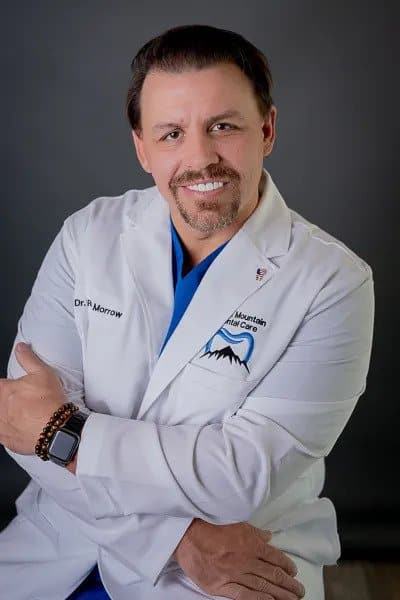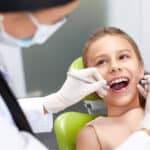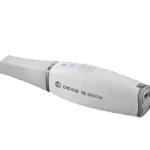Russell Morrow, DDS, chief dental officer at Biolase, joins the podcast to talk about the use of lasers in the orthodontic practice and opportunities that are being missed.
- As the price of dental lasers have come down, it’s easier than ever to bring in a diode or soft tissue laser into the practice. Morrow talks about how there is an opportunity to make the use of dental lasers the standard of care amongst the dental specialties.
- Morrow talks about how having a dental laser in the practice allows you to avoid sending patients out for referrals. He gives the example of an impacted canine. Instead of sending a patient out to an oral surgeon, the orthodontist could use a soft tissue laser in the office to uncover and remove the bone, attach a bracket, and then pull that canine down.
- When it comes to clear aligner therapy, Morrow shares how he uses a soft tissue laser on patients with a diastema, adding a buccal frenectomy and gingivectomy. He explains how you aren’t doing work that doesn’t need to be done. “You’re actually doing better work in order for that patient to be happy,” says Morrow.
- Another application for orthodontists, according to Morrow, is the use of a lower wavelength laser to aid in tooth movement. Morrow explains how you can utilize the laser on the buccal surface to excite the bone and help regenerate it to make it more active. In this case, it’s not about using the laser to cut, but rather to cause the healing process. As he puts it, “The aligners are going to fit better. Teeth are going to move better.”
- Pain relief is another opportunity to put a dental laser to good use in the orthodontic practice, says Morrow. Whether it’s an aphthous ulcer or canker sore, orthodontists can use that laser and bring the healing time from about 10 to 3 days, and the pain level down from a 7 to a 2, according to Morrow.
- Morrow champions the use of photography to document your cases before and after using a laser in treatment. Those photos not only show the patient how far they’ve come, but they also can be shared with the next patient. “And that’s just a snowball effect,” says Morrow. “As you show your work, you’re going to get more work.”
- When it comes to training, Morrow explains that most dental laser companies selling diode lasers will provide training. Biolase provides 6 hours of CE to customers, according to Morrow.

Podcast Transcript
Alison Werner 0:10
Hello, I’m Alison Werner, host of the orthodontic products podcast today I have with me Dr. Russell Morrow, Chief dental officer at the dental laser company Biolase. He’s here to talk about the use of lasers in the orthodontic practice and where the technology is today. Here’s our conversation. Dr. Morrow, thank you for joining me.
Dr Russell Morrow 0:26
Thank you for having me.
Alison Werner 0:28
So as I said, you were the chief dental officer Biolase. Can you talk about that role and your career in dentistry?
Dr Russell Morrow 0:34
Well, the chief dental officer is just a small part of what I do. So I started out, I guess, as a baby dentist, with a small DSO. And that DSO had seven offices and we grew to 28. And then one day, the CEO of that company, tapped me on the shoulder and said, Hey, I just sold to Heartland Dental. And I said, What does this mean for me, and he says, Just keep drilling. And so that’s what I’ve done for my whole careers. I just kept drilling. And, and so I actually currently still am employed with Heartland Dental. And we’ve now got, I think it’s like 1800 offices nationwide. And one of the big stress stress procedures that Heartland tell teaches us is clear, aligner therapy. And so that’s where that comes in. For me, I’m still a practicing dentist, I only them down to one day a week clinically. And then I started with Biolase, about a year ago as their Chief dental officer. And, and I’ve been using lasers pretty much the whole the whole time while I’ve been a dentist as well as doing orthodontics, to supplement my patients and be able to fully give my patients everything they need, deserve and desire.
Alison Werner 1:51
So what attracts you to the use of lasers?
Dr Russell Morrow 1:55
Well, for me, a laser is just a tool or an instrument. It’s not a specific procedure, but it’s what I can do with all the other things that I do. So if I’m doing a filling, and I have a hard time getting isolation, I get the laser out to be able to isolate it, or I can use it in perio. Or I can use it in endo or in ortho, which I routinely do a lot too.
Alison Werner 2:19
I had said that I want to talk today about lasers and orthodontics, the products available, how they’re used what orthodontists should know about incorporating them into their clinical workflow. But to get started, can you talk about where dental laser technology is today?
Dr Russell Morrow 2:32
That’s a great question. So if you use the term lasers, that’s a really big term because there’s a ton of different lasers out there that do a lot of different things. Some lasers just are there for healing. Others do things like cutting and and, and others can cut bone and cut tooth. And so you’ve got a wide variety of different things that you can do with lasers. Dental lasers, at this point in many of our practices have gotten the less expensive, so they’re starting to show up in most dental practices, at least some of the low level diode or soft tissue lasers. They almost I have a hard time throwing this word around with being standard of care. And I say that because I also currently serve on the Arizona State Dental Board, where we talk about standard of care all the time. But we’ve got so much research that shows that use of lasers in your practice helps make the dentistry better. It helps things like periodontal disease decreased dramatically when you add a diode laser to your hygienist cleanings. And the when you talk about standard of care, it’s being able to have access to something that’s affordable for most dentists to be able to have in their practice that’s going to provide better dentistry. And that’s why I say that dentists or dental use of dental lasers have gotten to be so available that it’s almost to the point where we if you’re not using a laser, you’re missing an upgrade opportunity.
Alison Werner 4:06
Okay, so then what types of lasers I know just from my experience, we often talks about soft tissue or the diode lasers for the orthodontic setting is that primarily what the orthodontic community would be working with?
Dr Russell Morrow 4:20
I think that makes a lot of sense. When you start getting the all tissue lasers, the ones that remove tooth and bone. orthodontists tend to stay in the soft tissue realm. And so the cost benefit for a soft tissue diode is much less than an all tissue however, the the hard and soft tissue can impact things like if you have an impacted canines. Instead of sending that to an oral surgeon. You could do it in your own practice uncovered remove bone, attach a bracket and then be able to pull that canine down. So that’s where that soft tissue hard tissue combination would come in with orthodontics, but you’re not doing that every A and it’s not like in terms of cost benefit. It’s great for a GP because we’re using it for a ton of other procedures. Whereas an orthodontist, they’re worried about finalizing their cases we’re worried about getting, getting the occlusion set and all the other stuff making predictable movements. Where if they’re, if they had a big expensive all tissue laser, they’d use it very little. In comparison, they would have diode.
Alison Werner 5:26
So let’s get down to basics. What procedures are what are the common uses for lasers in orthodontics, you talked a little bit there about the unerupted tooth, but what else is there?
Dr Russell Morrow 5:38
So let me tell you how I present my all tissue, my clear aligner therapy page to my patients. Whenever I have a patient with a diastema, the first thing I always look for is that frenum, that soft tissue frenum, and that that could bind in a way of being able to close that space. So I add a frenectomy. A buccal frenectomy, remember you have a bunch of frenums, but I also look for the lingual frenectomy too, if you’ve got teeth, it can’t close because of the extra tissue. The other thing I add is I add a gingivectomy, which is removing some tissue on on the anterior teeth, to be able to make sure the heights, the gingival heights or zeniths, all match up where they should. And so I had two codes, I had gingivectomies one to three on both sides. So in the end, it actually increases my average treatment plan if I add the three by about $1,200. And so you’re adding $1,200 to your existing treatment plan, and you’re not doing work that doesn’t need to be done, you’re actually doing better work in order for that patient to be happy, and get the things done that they want to that they expect. And if your work looks better than you take great photos, you can share that with the next person. And that’s just a snowball effect, that as you show your work, you’re gonna get more work. So that’s how I use it.
Alison Werner 7:00
Okay, do you think there are applications that orthodontists are missing out on? You talked there about aligner in the course of aligner treatments, but are there other applications that anything you think orthodontists just aren’t realizing they could be doing?
Dr Russell Morrow 7:13
Oh, yeah, absolutely. Now there’s a lot of research has recently shown that if you use a pain therapy handpiece from a laser, or a low level like a lower wavelength of laser, you can use that to aid in the tooth movement. So utilizing this on the buccal surface, would help excite the bone help regenerate the bone and help be fully make that bone more active. Therefore, the aligners are going to fit better teeth are going to move better. And so every time in my practice when they come in for aligner swaps, or if I’m having a hard time getting a tooth to move specifically, I’ll have them come in a couple of times and use the laser on the buccal of that tooth in order to be able to get that tooth to move better. So it doesn’t cut it actually just causes the healing process. And and that’s one thing I’m sure not a lot of people are using. But there’s a lot of research that recently shows the benefit of using a laser in that fashion.
Alison Werner 8:15
For those orthodontists who haven’t used lasers in their practice, there might be a hesitation that they don’t know how to get started or you know, they’re worried about risk, what would you say to them in terms of how to minimize risk of complications or just you know how to get started?
Dr Russell Morrow 8:32
You know, it’s one of those things that among general dentists, we always kind of laugh that orthodontists forget to how to use needles, because they they don’t give a ton of injections anymore. And then 10 They see blood that gets a little anxious and me someplace Tad’s and other things in the bone. But orthodontists don’t like to slow down and and pull out a blade or pull out a laser. They sometimes refer that stuff out, you’ll find that these procedures are doing things like a gingivectomy or frenectomy, very simple, easy infiltration processes. And the only key thing you have to remember is how to understand biologic width. biologic width is where the gum ends and where the bone begins. And you have to have a certain amount of distance between them in order to create the ideal gum, gum healing. And so if you don’t have enough biologic width, it can make the gums red around the edge. And the simple math equation, you need three millimeters of probing depth from the gingival edge to the bone. And if you have five millimeters, you can actually then five minus three is two. It’s simple math at that point. So it does it’s not brain surgery. It’s just a matter of having the first couple of cases taking them on. In fact that a shout out to the orthodontist that taught me ortho His name is Neal Kravitz.
Alison Werner 9:57
Neal feels a very good friend of mine
Dr Russell Morrow 10:00
I love Neal.
Yeah, I I spent every Tuesday for six hours in his office for 10 months. And and Neal taught me how the importance of taking photos he taught me the importance of making sure you’re finishing your cases, appropriately. And and so Neal actually was the first orthodontist I saw that used a laser to be able to finish his cases. And and he kind of instilled that in me as a as a baby dentist, back in 2007 2008, something like that. So and Neal’s a great buddy.
Alison Werner 10:36
Is there anything orthodontists should know between using a laser with a pediatric patient versus or an adolescent patient versus an adult,
Dr Russell Morrow 10:45
not really any tissues, tissues tissue, there are certain types of lasers that if you do it and do it at a low level, you can oftentimes do without any anesthetic as well. And so, if I had a kid, I probably wouldn’t risk it. But as an adult, you probably can get away with doing it without causing too much discomfort by using the topical anesthetic. So that would be the only difference that you you may want to think about is whether or not to use anesthetic or whether you don’t, how would
Alison Werner 11:14
you say that the soft tissue lasers or the diode lasers have evolved? Is there any kind of progression in the technology that you’ve seen in the last few years?
Dr Russell Morrow 11:23
So lasers are really, really old term? It was it started with the guy who first postulated was Albert Einstein. So that tells you how long lasers have been around. Dental laser has been around for decades and decades and decades. What it is, and basically, it’s just physics, it’s how light interacts with, with what you’re attempting to deal with. What we’re seeing now is the ability for that to be easier that the delivery device is much better. The lasers now are much sexier than they were when I was when I was a new dentist. But I had to you have this big long glass tube and I have to had you said a cut it and made sure it was cut properly. Now it’s all done. It’s a push button thing, push it figure out what you want to do. And there’s no get it’s no guesswork. It just it says frenectomy you click on frenectomy. And you go so the delivery device is the only thing that’s changed, but the physics is the same.
Alison Werner 12:21
What kind of training or education do you recommend for an orthodontist who is looking to incorporate this?
Dr Russell Morrow 12:26
Well, basically, if you’re going to buy a diode laser, the company you buy it from should provide the training and at Biolase, I think it’s six hours of CE, they go and take a Saturday, they oftentimes can do an online as well. And it’ll teach you probably more than you want to know as an orthodontist, they’ll teach you everything from you know, lip and tongue ties to, to removing gums, to removing fibromas, and so forth. Oh, the other thing that may help, especially with Orthodontists is you have a setting that you can decrease the pain from an aphthous ulcer or a canker sore. And so if you’ve got a bracket that really sore, you can use that laser and it takes the healing time from about 10 days to about three and takes the pain from let’s say it’s a level seven down to like a two. So it’s immediately get relief and healing in just a couple of days rather than a long term. So that would be another really great addition to an orthodontic practice.
Alison Werner 13:30
You’ve talked a little bit there about opportunities for kind of like expanding the practice or growing the practice kind of financially but also in terms of like patient compliance and patient comfort. Is there anything else you would add to that in terms of you know, how that how adding lasers can fill out your practice.
Dr Russell Morrow 13:46
So I find that there are a lot of people that comment in my practice about how advanced we are. Versus there are other dentists. If you pull out the the laser, they’re going to say and notice that you’re taking a greater a greater effort for their oral health. It’s just the same thing when we used to take digital scanner digital X rays. If you were the first one on the block with a digital X ray, people walk into your office because they didn’t want to wait 20 minutes to go back and dip the tank and all the other stuff that used to happen. Now it’s the same kind of thing. If I said to a patient today, don’t worry, at the end of your orthodontic treatment, I’m going to take a scalpel out and I’m going to cut your gums. Don’t worry, you’re just going to bleed for about a half hour and it will hurt it’ll be a little swollen but you’ll be fine. Versus I’m going to take a laser out there’ll be no pain, no bleeding, and you’ll heal almost immediately. The difference in that is amazing. Now that they do the same thing. In the end, you’ll get the same result the gingivectomy should stay and give you an ideal, but a patient will look at the scalpel and say nope, not coming back here. And so that would be the difference in being able to the public perception of of technology I think is really simple. Wouldn’t
Alison Werner 15:00
Yeah, absolutely. Are there any best practices that you recommend for orthodontists who you know, are either working with it now or who are just getting started.
Dr Russell Morrow 15:09
So of course, I’m gonna go back to Neal Kravitz on this one, I think the most important thing you can do as an orthodontist for general dentists dealing with clear aligner therapy is great photography, you take great photography, take your befores and your Afters, and you show what you’ve done. Because that next patient is really important. So great photography before. And then being able to document where you were at, especially, insurances sometimes can pick up a portion of these gingavectomy procedures, because if you have a lot of tissue, and you document it, well, you should be able to send a lot of that to to your insurances. So that could pick up up to 80%, depending on the insurance. And again, you have to have the documentation and their reasoning to be able to do it. So that would be a huge deal is make sure you document your case as well, that goes back to being on the Dental Board. But more importantly, that you could share the your successes with your patients and what what they’re getting for the extra value, the extra value that you’re getting for the the extra dollar they’re spending.
Alison Werner 16:09
So my final question, what excites you about the future of lasers in dentistry or specifically orthodontics? If you could speak a little bit to that?
Dr Russell Morrow 16:17
I’ve been doing orthodontist I said since about 2007. So nothing’s new for me. Because I’ve been using light utilizing the same principles. What excites me is the greater use of lasers among and the adoption of lasers among our dental professionals, and how its how it’s almost becoming routine that you’re getting these treatments done. And that you have that in your hand, as an orthodontist, if you have to refer it out. Patients don’t want to have procedures referred out they don’t want to go anywhere else they’ve spent time with you, they spent effort and money with you. And and so that is they want to stay with you plus, you were the one that was the quarterback for that case, you want to finish it, you don’t want to put that on someone else because you had the vision, you know where those those teeth lined up. Because if you’re intruding a tooth, you’re going to enter that tooth, the tissue moves in with it. And you have to understand that you’re going to end up having a gingival discrepancy if you’re interpreting a tooth next to one you didn’t. So you may have to remove a little tissue, or sometimes even tissue and bone if you’re invaded that biologic with to be able to get the ideal smile line.
Alison Werner 17:24
Dr. Morrow, thank you so much for your time and your insight. I really appreciate it.
Unknown Speaker 17:29
Happy to be here. Thank you so much for having me.
Alison Werner 17:32
As always, thank you for joining us. Be sure to subscribe to the orthodontic products podcast to keep up with the latest episodes. And be sure to check out orthodontic products online.com to keep up with the latest industry news. Until next time, take care













